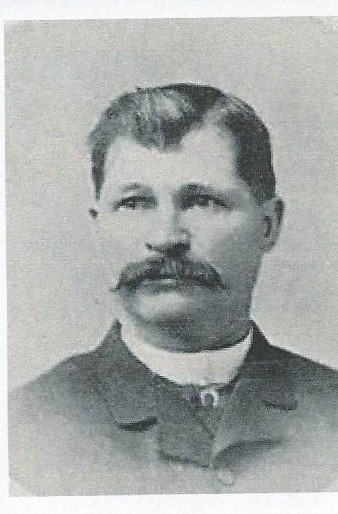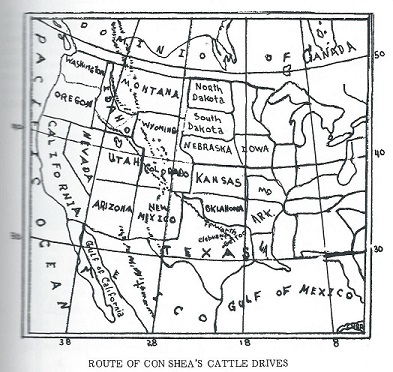

Con
Shea Basin is named after Cornelius (Con) Shea.
Shea was a pioneer rancher, who is credited with bringing beef cattle to
supply miners in Owyhee County during the late 1860s.
He was born in Ontario, Canada in 1840 and sailed around Cape Horn to
reach San Francisco in 1857. By
1864 Con Shea had moved to Silver City where he worked as a blacksmith, a miner,
and a teamster. He had the
reputation of being a gambler and drinker.
In the late 1860s, financier Christopher Moore asked him to trail a herd
of cattle from Texas to Silver City, where miners were hungry for meat.
I
Con
Shea headed to Texas in 1868 to buy cattle for financier Christopher Moore.
Enroute, he encountered a drive already on its way from Texas in the Raft River
Valley. Shea bought the herd and
drove the cattle to Sinker and Catherine Creeks, southeast of what is now
Murphy. Thus, Shea is said to be the first to have brought Texas cattle into
southwestern Idaho.
In
1869, Con Shea and a team of 15 buckaroos went to Texas and drove more than 1400
cattle, some of which were longhorns, from Central Texas to Owyhee County. The
trek over the dusty Osage,
Wichita, and Smoky Hill trails took 6 months.
Joseph and Martha McIntyre accompanied the drive in an ox-driven wagon
with seven children in tow from Collin County, Texas. Their 15-year-old
daughter, Marietta (Ettie), fell in love with Cornelius along the trail.
Shea led another cattle drive from Texas in 1870, but he sold the cattle
in Denver before returning to Idaho.
He and Ettie were married in December of that year and their marriage
lasted until Shea’s death in 1926.

Con
Shea is said to have received $20,000 in gold for the first herd that he brought
to Owyhee County. Con Shea used the basin between the mouth of Sinker Creek and
the mouth of Rabbit Creek to winter his cattle for many years.
Cattle thrived on the white sage (also called winterfat) and bunchgrass
that grew in the Basin. Winterfat and bunch grass are now rare in Con Shea
Basin, and the area is dominated by non-native grasses and weeds.
Con
Shea and two of his brothers took part in the Battle of South Mountain during
the Bannock War of 1878. Shea
played a major role in the Owyhee Country cattle business.
He left his name on Idaho’s Con Shea Basin and on Sheaville, Oregon.
In
1871 and 1873, David L. Shirk brought more cattle from Texas. Each drive lasted
6 months (April to October), during which they survived hailstorms, Indian
attacks, and treacherous river crossings.
A native of Indiana who came to Idaho in 1866, Shirk
wrote a
detailed journal recounting his 1871 and 1873 cattle drives and his years as a
cattleman in Idaho and Oregon. He spent time in both Silver City and Con Shea
Basin.
David
Shirk and his brother, William, worked for Con Shea off and on during the 1870s.
David Shirk and an assistant spent the winter of 1871-1872 in Con Shea Basin,
looking after the cattle they had brought from Texas.
They lived in a 10 x 14, 4-foot deep
dugout, covered with rye grass and dirt, about a mile and a half from the
confluence of Rabbit Creek and the Snake River.


For
many years, steers
were driven into Silver City every week to supply meat for mining camps.
From 1873-1899, cattle also were trailed from Owyhee County to Nevada,
Oregon, and other parts of Idaho.
In the
mid-1870s Shea moved his herds to ranges that straddled the Oregon border, about
15 miles northwest of Silver City. From 1871 to 1876, he and a brother ran a
meat market in a mining camp that flourished near Silver City.
Shea and two of his brothers took part in the Battle of South Mountain during
the Bannock Indian War of 1878.
By the 1880s there were more than 100,000 cattle in Owyhee County.
However, Con
Shea
and other ranchers lost most of their cattle in the severe winters of 1888-1890.
Shea
disposed of his Idaho and Oregon ranch holdings and moved to Santa Rosa,
California in 1897.
He invested in land and other real estate, eventually becoming one of Santa
Rosa’s larger property holders. Shea was considered a millionaire when he died
on May 20, 1926. He left behind a vast empire of real estate and other business
ventures.
White
Sage, also known as “winterfat” was abundant and was regarded by many as the
best winter forage in the world. It is one of the most valuable rangeland browse
plants for maintaining weight of animals on winter grazing range because of the
high crude protein content in winter. Native bunchgrasses also thrived in Con
Shea Basin. Winterfat and bunch
grass are now rare in Con Shea Basin, and the area is dominated by non-native
grasses and weeds.
https://sfcompanion.blogspot.com/2019/09/cattleman-con-shea-drives-texas.html
https://www.newspapers.com/article/the-press-democrat-obituary-cornelius/140982874/